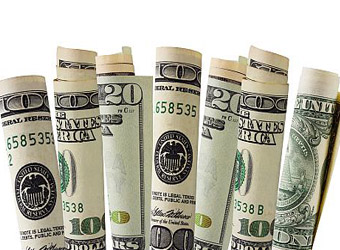The dollar remained on the defensive on Thursday, having tumbled after the Federal Reserve raised interest rates as expected, but left its rate outlook for the coming years unchanged.
There was limited reaction among major currencies after China raised interest rates marginally, in the wake of the Fed’s move.
The dollar index, which tracks the greenback against a basket of six major currencies, eased 0.1 percent to 93.372 after falling 0.7 percent on Wednesday.
The Fed raised key short-term rates by a quarter point to a range of 1.25-1.50 percent on Wednesday. The Fed projected three more hikes in both 2018 and 2019, unchanged from the last round of forecasts in September.
Traders and analysts said the dollar came under pressure after the Fed’s policy announcement as the U.S. central bank kept its interest rate projections steady rather than revising them higher.
Some market participants had speculated the Fed could raise its interest rate projection for next year to four rate hikes, said Stephen Innes, head of trading in Asia-Pacific for Oanda in Singapore.
“From the market perspective, anybody who was leaning that way basically ran for the exit,” Innes said, referring to the dollar’s drop after the Fed meeting.
Against the yen, the dollar inched up 0.1 percent to 112.62 yen, after sliding 0.9 percent on Wednesday and having retreated from Tuesday’s four-week high of 113.75 yen.
The euro edged up 0.1 percent to $1.1836, having climbed 0.7 percent on Wednesday.
The dollar was also weighed down after U.S. core consumer price data released on Wednesday showed slowing inflation, raising concerns the Fed will be less able to execute multiple rate increases next year.
But some analysts see hopes for progress on U.S. tax reform, including tax cuts, lending support to the dollar.
Congressional Republicans reached a deal on final tax legislation on Wednesday, clearing the way for final votes next week on a package that would slash the U.S. corporate tax rate to 21 percent and cut taxes for wealthy Americans.
Hours after the Fed’s rate hike, China’s central bank on Thursday raised interest rates for its reverse repos and medium-term lending facility (MLF) loans by 5 basis points.
“Five basis points is not going to make that much of a difference. But it is an important symbolic message in the right direction, that rates are going higher,” said Heng Koon How, head of markets strategy for United Overseas Bank in Singapore.
China’s move underscores the gradual moves toward monetary policy tightening taking place globally, Heng added.
Data showing a surge in Australian jobs growth in November gave a lift to the Aussie, which touched a one-month high of $0.7675, and was last up 0.4 percent on the day at $0.7665.
Later on Thursday, investors will turn their focus to monetary policy decisions by the European Central Bank and the Bank of England.
The BoE is widely expected to keep interest rates on hold at 0.5 percent on Thursday, after raising rates for the first time since 2007 last month.
The ECB is seen likely to keep interest rates steady and reaffirm its existing monetary policy stance, after having decided in October to halve bond buys to 30 billion euros a month from January. Source: Reuters
Source: Reuters


